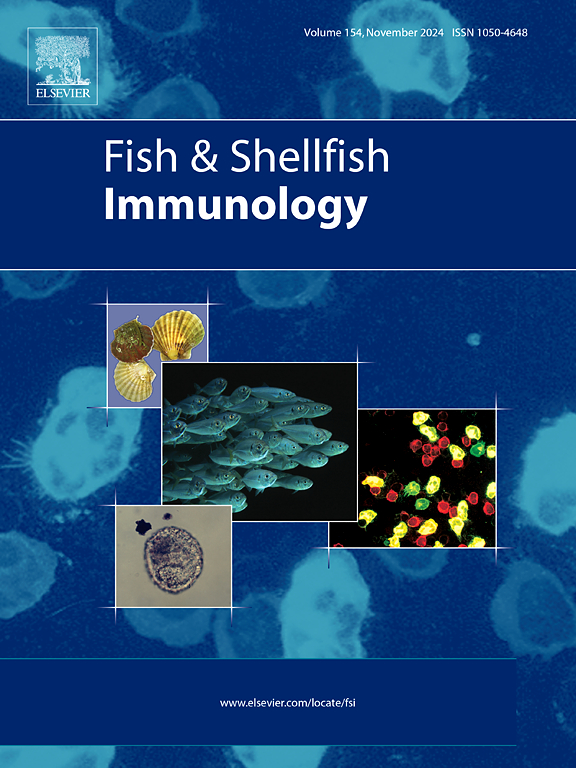RhoA, a small GTPase, inhibits bacterial infection through regulated phagocytosis in the Chinese mitten crab, Eriocheir sinensis
IF 3.9
2区 农林科学
Q1 FISHERIES
引用次数: 0
Abstract
Small GTPase RhoA is a pivotal regulator of cytoskeletal dynamics and phagocytosis in mammalian phagocytes, yet its functional role in crustacean immunity remains poorly characterized. In this study, we identified and characterized RhoA from Eriocheir sinensis (designated EsRhoA), demonstrating its essential role in hemocyte phagocytosis and antibacterial defense. The EsRhoA gene encodes a 257-amino-acid protein containing a conserved RHO domain and displays over 90 % sequence similarity to orthologs in both vertebrates and invertebrates. Transcriptional analysis revealed widespread expression of EsRhoA across various tissues, with a significant upregulation observed in hemocytes following infection with Vibrio parahaemolyticus. RNA interference (RNAi)-mediated knockdown of EsRhoA in hemocytes led to decreased expression of phagocytosis-related effectors ROCK2 and Arp2/3, resulting in a 62 % reduction in bacterial phagocytosis as measured by flow cytometry. Immunocytochemistry analysis confirmed that EsRhoA protein translocates to the hemocyte membrane during pathogen-induced phagocytosis, suggesting a mechanistic similarity to integrin-mediated internalization in mammalian cells. Importantly, in vivo knockdown of EsRhoA significantly increased bacterial loads in hemolymph and reduced crab survival after infection. Collectively, these findings establish EsRhoA as an evolutionarily conserved regulator of hemocyte phagocytosis that provides critical protection against bacterial pathogens in crustaceans, offering novel insights into the evolution of immune cell phagocytosis mechanisms and potential applications in crustacean aquaculture disease management.
RhoA是一种小GTPase,通过调节中华绒螯蟹的吞噬作用抑制细菌感染
小GTPase RhoA是哺乳动物吞噬细胞中细胞骨架动力学和吞噬作用的关键调节因子,但其在甲壳类动物免疫中的功能作用尚不清楚。在本研究中,我们从中华绒螯蟹(Eriocheir sinensis)中鉴定并表征了RhoA(简称EsRhoA),证明了其在血细胞吞噬和抗菌防御中的重要作用。EsRhoA基因编码一个含有保守RHO结构域的257个氨基酸的蛋白,在脊椎动物和无脊椎动物中显示出超过90%的同源序列相似性。转录分析显示,EsRhoA在各种组织中广泛表达,在感染副溶血性弧菌后,在血细胞中观察到显著上调。RNA干扰(RNAi)介导的血细胞中EsRhoA的敲低导致吞噬相关效应物ROCK2和Arp2/3的表达降低,通过流式细胞术测量,导致细菌吞噬减少62%。免疫细胞化学分析证实,在病原体诱导的吞噬过程中,EsRhoA蛋白易位到血细胞膜上,这表明其机制与哺乳动物细胞中整合素介导的内化相似。重要的是,体内敲除EsRhoA显著增加了血淋巴中的细菌负荷,降低了感染后螃蟹的存活率。总之,这些发现证实了EsRhoA作为一种进化保守的血细胞吞噬调节因子,在甲壳类动物中提供对细菌病原体的关键保护,为免疫细胞吞噬机制的进化和甲壳类动物养殖疾病管理中的潜在应用提供了新的见解。
本文章由计算机程序翻译,如有差异,请以英文原文为准。
求助全文
约1分钟内获得全文
求助全文
来源期刊

Fish & shellfish immunology
农林科学-海洋与淡水生物学
CiteScore
7.50
自引率
19.10%
发文量
750
审稿时长
68 days
期刊介绍:
Fish and Shellfish Immunology rapidly publishes high-quality, peer-refereed contributions in the expanding fields of fish and shellfish immunology. It presents studies on the basic mechanisms of both the specific and non-specific defense systems, the cells, tissues, and humoral factors involved, their dependence on environmental and intrinsic factors, response to pathogens, response to vaccination, and applied studies on the development of specific vaccines for use in the aquaculture industry.
 求助内容:
求助内容: 应助结果提醒方式:
应助结果提醒方式:


